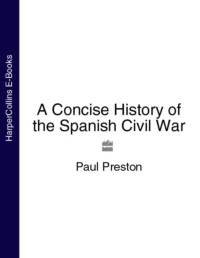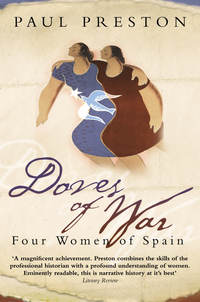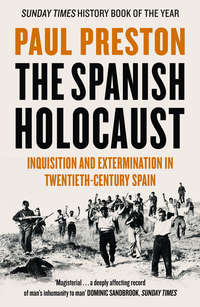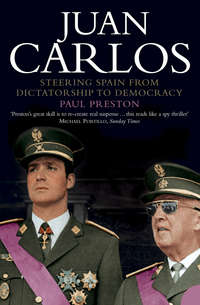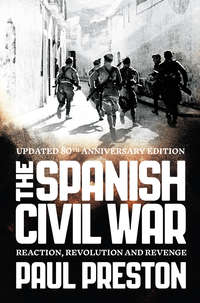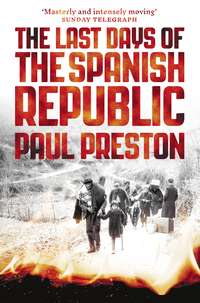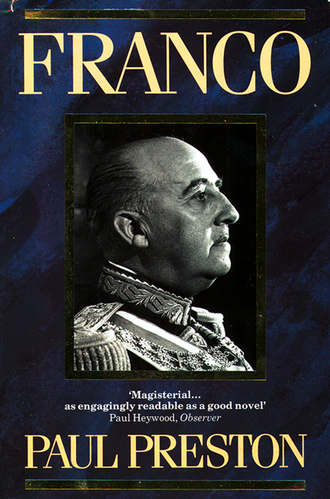
Полная версия
Franco
On 31 March 1934, two Carlist representatives accompanied by the leader of the Alfonsist monarchist party, Renovación Española, Antonio Goicoechea, and General Barrera saw Mussolini in Rome. They signed a pact which promised money and arms for a rising.8 In May 1934, the monarchists’ most dynamic and charismatic leader, José Calvo Sotelo, was granted amnesty and returned to Spain after the three years’ exile suffered as he fled the ‘responsibilities’ campaign. Henceforth, the extreme rightist press, in addition to criticizing Gil Robles for alleged weakness, began to talk of the need to ‘conquer the State’ – a euphemism for the violent seizure of its apparatus, as the only certain way to guarantee a permanent authoritarian, corporative regime.
Although Franco was careful to distance himself from the generals who were part of monarchist conspiracies, he certainly shared some of their preoccupations. His ideas on political, social and economic issues were still influenced by the regular bulletins which had been receiving since 1928 from the Entente Internationale contre la Troisième Internationale of Geneva. In the spring of 1934, he took out a new subscription at his own expense, writing to Geneva on 16 May expressing his admiration for ‘the great work which you carry out for the defence of nations from Communism’ and his ‘wish to co-operate, in our country, in your great effort’.9 An ultra-right-wing organization which now had contacts with Dr Goebbels’ Antikomintern, the Entente skilfully targeted and linked up influential people convinced of the need to prepare for the struggle against Communism, and supplied subscribers with reports which purported to expose plans for forthcoming Communist offensives. The many strikes which took place during 1934, when seen through the prism of the Entente’s publications, helped convince Franco that a major Communist assault on Spain was under way.10
If Franco was circumspect with regard to extreme Right monarchist conspirators, he had even less to do with the nascent fascist groups which were beginning to appear on the scene. Gil Robles’ youth movement, the Juventud de Acción Popular (JAP) held great fascist-style rallies were held at which Gil Robles was hailed with the cry ‘¡Jefe! ¡Jefe! ¡Jefe!’ (the Spanish equivalent of Duce) in the hope that he might start a ‘March on Madrid’ to seize power. However, the JAP was not taken seriously by the ‘catastrophist’ Right. Monarchist hopes focused rather more on the openly fascist group of José Antonio Primo de Rivera, the Falange, as a potential source of shock troops against the Left. As a southern landowner, an aristocrat and eligible socialite, and above all as the son of the late dictator, José Antonio Primo de Rivera was a guarantee to the upper classes that Spanish fascism would not get out of their control in the way of its German and Italian equivalents. The Falange remained insignificant until 1936, important until then only for the role played by its political vandalism in screwing up the tension which would eventually erupt into the Civil War. José Antonio was a close friend of Ramón Serrano Suñer, Franco’s brother-in-law, but despite Serrano’s efforts to bring them together, the cautious, hard-working general and the flamboyant playboy would never hit it off.
Indeed, during the first half of 1934, Franco’s interest in politics was minimal. In late February, his mother Pilar Bahamonde de Franco had decided to go on pilgrimage to Rome. Franco travelled to Madrid in order to escort her to Valencia to catch a boat to Italy. While in the capital, staying at the home of her daughter Pilar, she caught pneumonia. After an illness lasting about ten days, she died on 28 February, aged sixty-six. It is the unanimous affirmation of those close to him that the loss affected Francisco profoundly despite the fact that he had not lived with his mother for twenty-seven years. He had adored her.11 Outside the family, he showed no signs of his bereavement. After her death, Franco rented a large apartment in Madrid where he and his wife regularly received the visits of other generals, prominent right-wing politicians, aristocrats and the elite of Oviedo when they passed through the capital. The most frequent recreations of Francisco and Carmen were visits to the cinema and to the flea-market (Rastro) in search of antiques, often accompanied by their favourite niece Pilar Jaraiz Franco.12
While Franco concerned himself with family and professional matters, the political temperature was rising throughout Spain. The Left was deeply sensitive to the development of fascism and was determined to avoid the fate of their Italian, German and Austrian counterparts. Encouraged by Gil Robles, the Radical Minister of the Interior Rafael Salazar Alonso was pursuing a policy of breaking the power of the Socialists in local administration and provoking the unions into suicidal strikes. The gradual demolition of the meagre Republican-Socialist achievements of 1931–1933 reached its culmination on 23 April with the amnesty of those accused of responsibilities for the crimes of the Dictatorship, like Calvo Sotelo, and those implicated in the coup of 10 August 1932, most notably Sanjurjo himself. Lerroux resigned in protest after Alcalá Zamora had hesitated before signing the amnesty bill. While Lerroux ran the government from the wings, one of his lieutenants, Ricardo Samper, took over as prime minister. Socialists and Republicans alike felt that the entire operation was a signal from the Radicals to the Army that officers could rise whenever they disliked the political situation.13 The Left was already suspicious of the government’s dependence on CEDA votes, because the monarchist Gil Robles refused to affirm his loyalty to the Republic.
Political tension grew throughout 1934. Successive Radical cabinets were incapable of allaying the suspicion that they were merely Gil Robles’ Trojan Horse. By repeatedly threatening to withdraw his support, Gil Robles provoked a series of cabinet crises as a result of which the Radical government took on an ever more rightist colouring. On each occasion, some of the remaining liberal elements of Lerroux’s party would be pushed into leaving it and its rump became progressively more dependent on CEDA whims. With Salazar Alonso provoking strikes throughout the spring and summer of 1934 and thereby picking off the most powerful unions one by one, the government widened its attacks on the Republic’s most loyal supporters and also began to mount an assault against the Basques and, even more so, the Catalans.
In Catalonia, the regional government or Generalitat was governed by a left Republican party, the Esquerra, under Luis Companys. In April, Companys had passed an agrarian reform, the Ley de Cultivos, to protect tenants from eviction by landowners. Although Madrid declared the reform unconstitutional, Companys went ahead and ratified it. Meanwhile, the government began to infringe the Basques’ tax privileges and, in an attempt to silence protest, forbade their municipal elections. Such high-handed centralism could only confirm the Left’s fears of the Republic’s rapid drift to the right. That anxiety was intensified by Salazar Alonso’s provocation and crushing defeat of a major national strike by the Socialist landworkers’ union during the summer. There were hundreds of arrests of trade union leaders and thousands of internal deportations, with peasants herded onto trucks and driven hundreds of miles from their homes to be left to make their way back without food or money. In the meantime, Army conscripts brought in the harvest. Workers’ societies were closed down and leftists on town councils forcibly replaced by government nominees. In the Spanish countryside, the clock was being put back to the 1920s.14
The vengeful policies pursued by the Radical governments and encouraged by the CEDA divided Spain. The Left saw fascism in every action of the Right; the Right, and many Army officers, smelt Communist-inspired revolution in every demonstration or strike. In the streets, there was sporadic shooting by Socialist and Falangist youths. The Government’s attacks on regional autonomy and the increasingly threatening attitude of the CEDA were driving sections of the Socialist movement to place their hopes in a revolutionary rising to forestall the inexorable destruction of the Republic. On the Right, there was a belief that, if the Socialists could be provoked into an insurrection, an excuse would be provided to crush them definitively. Gil Robles’ youth movement, the JAP, held a rally on 9 September at Covadonga in Asturias, the site of a battle in 732 considered to be the starting point for the long reconquest of Spain from the Moors. The symbolic association of the right-wing cause with the values of traditional Spain and the identification of the working class with the Moorish invaders was a skilful device that would help secure military sympathy. It foreshadowed the Francoist choreography of the Reconquista developed after 1936 with Franco himself cast as the medieval warrior king.
At the rally, Gil Robles spoke belligerently of the need to crush the ‘separatist rebellion’ of the Catalans and the Basque Nationalists.15 The wily Gil Robles – the politician on the Right with the greatest strategic vision – knew that the Left considered him a fascist and was determined to prevent the CEDA coming to power. He therefore pushed for the CEDA to join the government precisely in order to provoke a Socialist reaction. This is in fact what happened. CEDA ministers entered the cabinet; there was an uprising in Asturias and it was smashed by the Army.16 Gil Robles said later: ‘I asked myself this question: “I can give Spain three months of tranquillity if I do not enter the government. If we enter, will the revolution break out? Better that it do so before it is well prepared, before it defeats us.” This is what we did, we precipitated the movement, met it and implacably smashed it from within the government’.17
In September, Franco left the Balearics and travelled to the mainland to take up Diego Hidalgo’s invitation to join him as his personal technical adviser during the Army manoeuvres taking place in León at the end of the month under the direction of General Eduardo López Ochoa. Since López Ochoa had been part of the opposition against Primo de Rivera and was implicated in the December 1930 military rebellion, Franco regarded him with some hostility. It is possible that the large-scale military manoeuvres, planned in the late spring, were part of a wider project by Salazar Alonso, Hidalgo and Gil Robles to crush the Left. The manoeuvres were held in an area contiguous, and of nearly identical terrain, to Asturias where the final left-wing bid to block the CEDA’s passage to power was likely to come.18 In retrospect, it seems more than a coincidence that the Minister of War should have arranged for Franco to accompany him as his personal adviser on those manouevres and should then put him in charge of the repression of the revolutionary strike.
It is not clear why the Minister needed a ‘personal technical adviser’ when López Ochoa and other senior officers, including the Chief of the General Staff, were there under his orders. On the other hand, if the central concern was the ability of the Army to crush a left-wing action, Franco was more likely to give firm advice than López Ochoa or General Carlos Masquelet, the Chief of Staff. Franco’s first biographer, Joaquin Arrarás, claimed that when Hidalgo invited Franco to leave the Balearics and come to the mainland, ‘his real intention was to ensure that the general would be in Madrid at the Minister’s side during the hazardous days which were expected’.19 There can be no doubt that Hidalgo was aware of a possible left-wing insurrection. At the end of August, he had named General Fanjul to head an investigation into the loss of weapons from the state small-arms factories.20 Then, in early September, when some members of the cabinet had been in favour of cancelling the manoeuvres, Hidalgo insisted that they go ahead precisely because of imminent left-wing threats. Three days before the manoeuvres began, Hidalgo ordered the Regiment no.3 from Oviedo which was to have taken part not to leave the Asturian capital again because he expected a revolutionary outbreak.21 Moreover, the astonishing speed with which Franco was later able to get the Spanish Legion from Africa to Asturias suggests some prior consideration of the problem.
On the Right, the readiness of the Army to deal with a likely leftist initiative was an issue of frequent discussion. Salazar Alonso raised it at cabinet meetings and in press interviews. At this time, secret contacts between the CEDA and senior military figures had provided assurances that the Army was confident of being able to crush any leftist uprising provoked by CEDA entry into the cabinet.22 Curiously, during the manoeuvres, José Antonio Primo de Rivera made an effort to cultivate a relationship with Franco. On the fringe of events, but clearly impressed by indications of Franco’s likely influence on what was about to happen, the Falange leader wrote him a frantic letter* claiming that Socialist victory was imminent and equivalent to ‘a foreign invasion’ since France would seize the opportunity to annex Catalonia. It is indicative of Franco’s confidence in Diego Hidalgo at this time that he read José Antonio’s letter without interest and did not bother to reply.23
Nevertheless, the political crisis was soon to absorb Franco totally. On 26 September, Gil Robles made his move and announced that the CEDA could no longer support a minority government. In dutiful response, Lerroux formed a new cabinet including three CEDA ministers. There was outrage among even conservative Republicans. The UGT called a general strike. In most parts of Spain, the prompt action of the government in declaring martial law and arresting the hesitant Socialist leaders guaranteed its failure.24 In Barcelona events were more dramatic. Pushed by extreme Catalan nationalists, and alarmed by developments in Madrid, Companys proclaimed an independent state of Catalonia ‘within the Federal Republic of Spain’ in protest against what was seen as the betrayal of the Republic. It was a largely rhetorical gesture since the rebellion of the Generalitat was doomed when Companys refused to arm the workers. The futile defence of the short-lived Catalan Republic was undertaken by a small group of officers from the local security services. They were soon overwhelmed.25 The only place where the Left’s protest was not easily brushed aside was in Asturias. There, the emergence of spontaneous rank-and-file revolutionary committees impelled the local Socialist leaders to go along with a movement organized jointly by the UGT, the CNT and, belatedly, the Communists, united in the Alianza Obrera (workers’ alliance).26
During the September manoeuvres, Franco had asked the Minister for permission to visit Oviedo on family business before returning to the Balearics – Franco planned to sell some land belonging to his wife. However, before he could set off from Madrid, the Asturian revolutionary strike broke out. Diego Hidalgo decided that Franco should stay on at the Ministry as his personal adviser.27 The situation worsened and, on 5 October, the Civil Governor of Asturias handed over control of the region to the military commander of Oviedo, Colonel Alfredo Navarro, who immediately declared martial law. At a tense cabinet meeting on 6 October, chaired by the President of the Republic Alcalá Zamora, it was decided to name General López Ochoa to command the troops sent to fight the revolutionary miners. The choice of López Ochoa for this difficult task reflected both his position as Inspector General del Ejército in the region and his reputation as a loyal republican and a freemason. López Ochoa later confided to the Socialist lawyer Juan-Simeón Vidarte that Alcalá Zamora had asked him to undertake the task precisely because he thereby hoped to keep bloodshed to a minimum. This created serious friction with Hidalgo, Salazar Alonso and the three new CEDA ministers who, urged on by Gil Robles, had been in favour of sending General Franco. They then tried unsuccessfully to have Franco named Chief of the General Staff instead of the more liberal incumbent, Masquelet, a friend of Azaña.28
Although the proposal to put Franco formally in command of troops in Asturias was rejected by Alcalá Zamora, Diego Hidalgo informally put him in overall charge of operations. Franco thus received an intoxicating taste of unprecedented politico-military power. The Minister used his ‘adviser’ as an unofficial Chief of the General Staff, marginalising his own staff and slavishly signing the orders which Franco drew up.29 In fact, the powers informally exercised by Franco went even further than might have been apparent at the time. The declaration by decree of martial law (estado de guerra) effectively transferred to the Ministry of War the responsibilities for law and order normally under the jurisdiction of the Ministry of the Interior. Diego Hidalgo’s total reliance on Franco effectively gave him control of the functions of both Ministries.30 The Minister’s desire to have Franco by his side in Madrid is comprehensible. He admired him and Franco had specific knowledge of Asturias, its geography, communications and military organization. He had been stationed there, had taken part in the suppression of the general strike of 1917 and had been a regular visitor since marrying Carmen. Nevertheless, the particularly harsh manner in which Franco directed the repression from Madrid gave a stamp to the events in Asturias which they might not have had if control had been left to the permanent staff of the Ministry.
The idea that a soldier should exercise such responsibilities came naturally to Franco. It harked back to the central ideas on the role of the military in politics which he had absorbed during his years as a cadet in the Toledo Academy. It was a step back in the direction of the golden years of the Primo de Rivera dictatorship. He took for granted the implicit recognition of his personal capacity and standing. All in all, it was to be a profoundly formative experience for him, deepening his messianic conviction that he was born to rule. He would try unsuccessfully to repeat it after the Popular Front election victory in February 1936 before doing so definitively in the course of the Civil War.
Hidalgo’s decision to use Franco derived also from his distrust, fuelled by Gil Robles, of both General Masquelet and other liberal officers in the Ministry of War who had been close to Azaña.31 At the time, the unusual appointment provoked criticisms from the under-secretary of the Ministry of War, General Luis Castelló.32 Franco’s approach to the events of Asturias was coloured by his conviction, fed by the material he received from the Entente Anticomuniste of Geneva, that the workers’ uprising had been ‘deliberately prepared by the agents of Moscow’ and that the Socialists ‘with technical instructions from the Communists, thought they were going to be able to install a dictatorship’.33 That belief no doubt made it easier to use troops against Spanish civilians as if they were a foreign enemy.
In the telegraph room of the Ministry of War, Franco set up a small command unit consisting of himself, his cousin Pacón and two naval officers, Captain Francisco Moreno Fernández and Lieutenant-Commander Pablo Ruiz Marset. Having no official status, they worked in civilian clothes. For two weeks, they controlled the movement of the troops, ships and trains to be used in the operation of crushing the revolution. Franco even directed the naval artillery bombardments of the coast, using his telephone in Madrid as a link between the cruiser Libertad and the land forces in Gijón.34 Uninhibited by the humanitarian considerations which made some of the more liberal senior officers hesitate to use the full weight of the armed forces against civilians, Franco regarded the problem before him with icy ruthlessness.
The rightist values to which he was devoted had as their central symbol the reconquest of Spain from the Moors. Yet, doubting the readiness of working class conscripts to fire on Spanish workers, and anxious not to encourage the spread of revolution by weakening garrisons elsewhere in the mainland, Franco had no qualms about shipping Moorish mercenaries to fight in Asturias, the only part of Spain where the crescent had never flown. There was no contradiction for him in using the Moors in the simple sense that he regarded left-wing workers with the same racialist contempt with which he had the tribesmen of the Rif. ‘This is a frontier war’, he commented to a journalist, ‘against socialism, Communism and whatever attacks civilization in order to replace it with barbarism’.35 Two banderas of the Legion and two tabores of Regulares were sent to Asturias with unusual speed and efficiency.
When it became known that one of the officers in charge of the troops coming from Africa, Lieutenant-Colonel López Bravo, had expressed doubts as to whether they would fire on civilians, Franco recommended his immediate replacement. He placed his Academy contemporary and close friend Colonel Juan Yagüe in overall charge of the African troops. He also ordered the removal of the commander of the León Air Force base, his cousin and childhood friend, Major Ricardo de la Puente Bahamonde, because he suspected that he sympathized with the miners and was ordering his pilots not to fire on the strikers in Oviedo. Almost immediately, Franco ordered the bombing and shelling of the working class districts of the mining towns. Some of the more liberal generals regarded such orders as excessively brutal.36
The losses among women and children, along with the atrocities committed by Yagüe’s Moroccan units, contributed to the demoralization of the virtually unarmed revolutionaries. Yagüe sent an emissary to Madrid to complain to both Franco and Gil Robles about the humanitarian treatment given by López Ochoa to the miners. López Ochoa’s pact with the miners’ leader Belarmino Tomás permitted an orderly and bloodless surrender and so provoked Franco’s suspicions.37 In contrast, Franco showed total confidence in Yagüe during the active hostilities, in the course of which a savage repression was carried out by the African troops. When Gijón and Oviedo were recaptured by government troops, summary executions of workers were carried out.38
Thereafter, Franco also put his stamp on the political mopping up. After the miners surrendered, Hidalgo and Franco regarded their task as unfinished until all those involved had been arrested and punished. After Hidalgo ‘took advice’, presumably Franco’s, the police operations were entrusted to the notoriously violent Civil Guard Major Lisardo Doval who was appointed on 1 November ‘delegate of the Ministry of War for public order in the provinces of Asturias and León’. Doval was widely considered an expert on left-wing subversion in Asturias. His fame as a crusader against the Left had made him immensely popular among the upper and middle classes of the region. He was given special powers to by-pass any judicial control or other legal obstacles to his activities. As Franco knew he would, Doval carried out his task with a relish for brutality which provoked horror in the international press. It has been suggested that Franco was unaware of either Doval’s methods or his reputation as a torturer.39 This is unlikely given that they had coincided as boys in El Ferrol, in the Infantry Academy at Toledo and in Asturias in 1917.
The right-wing press presented Franco, rather than López Ochoa, as the real victor over the revolutionaries and as the mastermind behind such a rapid success. Diego Hidalgo was unstinting in his praise for Franco’s value, military expertise and loyalty to the Republic and the rightist press began to refer to him as the ‘Saviour of the Republic’.40 In fact, Franco’s handling of the crisis had been decisive and efficient but hardly brilliant. His tactics, however, were interesting in that they prefigured his methods during the Civil War. They had consisted essentially of building up local superiority to suffocate the enemy and, as the use of Yagüe and Doval indicated, sowing terror within the enemy ranks.41
After the victory over the Asturian rebels, Lerroux and Gil Robles agonized over the issue of death penalties for the revolutionaries in Asturias and the officers who had defended the short-lived Catalan Republic. The trials which would make most impact on Franco were those involving charges of military rebellion. On 12 October 1934, the officers who had supported the rebellion in Catalonia had been tried and sentenced to death. Sergeant Diego Vázquez, who had deserted to join the strikers in Asturias, was tried and sentenced to death on 3 January 1935.42 The bulk of the Right howled for vengeance but Alcalá Zamora favoured clemency and Lerroux was inclined to agree. Many on the Right wanted Gil Robles to withdraw CEDA support for the government if the death sentences were not carried out. He refused for fear of Alcalá Zamora giving power to a more liberal cabinet.




